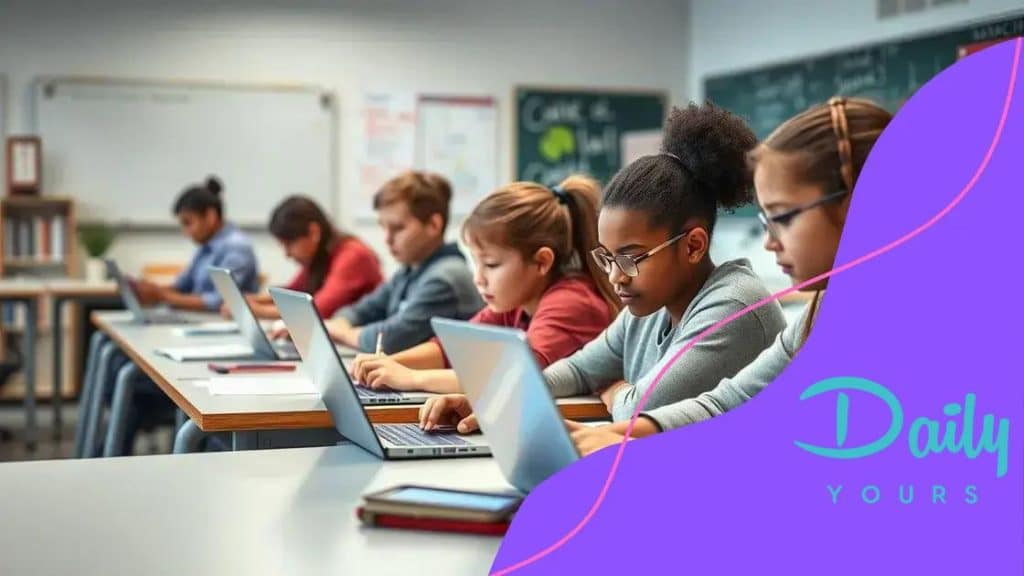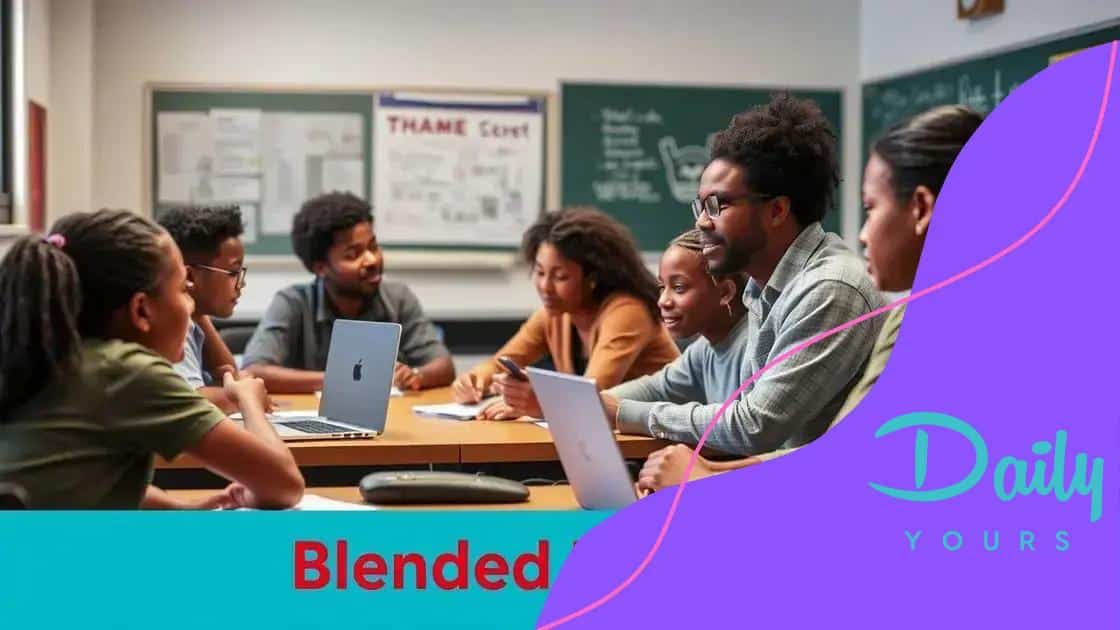Blended learning models: How they’re transforming universities

Anúncios
Blended learning models combine traditional classroom instruction with online components, offering flexibility, personalized learning, and enhanced engagement, making them an effective approach in higher education.
Blended learning models are changing the landscape of higher education. Have you ever thought about how this approach could enhance your learning experience? In this article, we’ll dive into how universities are adopting these innovative methods.
Anúncios
Understanding blended learning models
Understanding blended learning models is key to grasping how education is evolving. These models combine traditional classroom experiences with digital learning, offering a unique approach to education.
Blended learning occurs in various formats. One popular model is the rotation model, where students switch between learning on the computer and attending live classes. This method allows for personalized learning experiences.
Key Benefits of Blended Learning
Implementing blended learning brings numerous advantages. Here are some key benefits:
Anúncios
- Increased flexibility in learning schedules.
- Enhanced engagement through diverse teaching methods.
- Improved access to resources and materials online.
- Opportunities for self-paced learning.
Another model is the flipped classroom. In this setup, students learn new information at home, usually through videos, and use class time for collaboration and discussion. This method encourages active learning and better retention.
Challenges of Blended Learning
While there are many benefits, blended learning also has its challenges. Schools may struggle with:
- Ensuring all students have access to technology.
- Training teachers to utilize new tools effectively.
- Maintaining student engagement in online components.
As education continues to evolve, understanding how to incorporate and improve blended learning models will be crucial for educators and students alike. Being aware of the various models available equips schools to adopt methods that best fit their communities and learning goals.
Benefits of blended learning in universities
Blended learning in universities offers a variety of benefits that enhance the educational experience for both students and instructors. By combining traditional teaching methods with modern technology, universities can create a more engaging and effective learning environment.
One major advantage is the flexibility it provides. Students can access course materials online at their own pace, allowing them to review content whenever needed. This flexibility accommodates different learning styles and schedules, which is particularly beneficial for those balancing work and study.
Enhanced Learning Opportunities
Through blended learning, students gain access to a wider range of resources and tools. Online platforms can host interactive content, videos, and forums that encourage collaboration. This offers students the chance to grasp complex concepts more easily. The use of technology encourages critical thinking and promotes active participation in the learning process.
- Increased student engagement through multimedia resources.
- Opportunities for personalized learning experiences.
- Access to a broader range of perspectives through online discussions.
Blended learning also supports greater efficiency for educators. Instructors can utilize online assessments to gauge understanding and adapt teaching strategies accordingly. This approach allows for timely feedback, which can significantly improve student performance.
Improved Communication and Collaboration
Another benefit of blended learning is the improvement of communication between students and instructors. Online tools facilitate discussions that might not happen in traditional classrooms. This leads to deeper connections and collaborations among peers, enhancing the overall educational experience.
Overall, the integration of technology with traditional learning methods creates an adaptable and responsive educational setting.
Challenges in implementing blended learning

Implementing blended learning in educational institutions comes with its own set of challenges. Understanding these obstacles is essential for successful integration. One significant challenge is ensuring that all students have equal access to technology. Not every student may have a reliable computer or internet connection, which can hinder their ability to participate fully in online components.
Additionally, teachers may face difficulties in adapting to new technologies. Many educators are accustomed to traditional teaching methods and may struggle to incorporate digital tools effectively. This transition requires training and support to overcome initial hurdles.
Common Obstacles
Some common challenges in implementing blended learning include:
- Resistance to change from both educators and students.
- Limited training programs for teachers on using new technologies.
- Challenges in assessing student performance accurately.
Furthermore, maintaining student engagement in online environments can be tricky. Without the direct interaction of a traditional classroom, some students may feel isolated or unmotivated. To combat this, instructors need to create interactive and collaborative online experiences that keep students involved.
Institutional Barriers
Universities may also face institutional barriers. Budget constraints can limit the ability to implement comprehensive blended learning programs. Schools often need to prioritize spending on essential aspects, which can affect technology purchases or training initiatives.
Overall, while there are inherent challenges in implementing blended learning, understanding and addressing these issues is crucial for creating an effective educational environment.
Real-world examples of blended learning
Real-world examples of blended learning in universities showcase how this educational model brings innovative changes to traditional classrooms. Many institutions have begun to integrate online components into their curricula, allowing for a more interactive and flexible learning experience.
For instance, the University of Illinois has adopted a blended learning model in its engineering courses. Students participate in online lectures and complete assignments at their own pace. Then, they come to class for hands-on projects and group discussions. This method encourages collaboration while reinforcing technical skills.
Innovative Case Studies
Another example can be found at Colorado State University. They offer a blended learning program for their business courses. Students learn foundational concepts online and then engage in face-to-face sessions where they apply their knowledge through real-world simulations. This approach has improved student outcomes significantly.
- Increased student success rates through personalized learning.
- Enhanced engagement with interactive online tools.
- Opportunities for real-life applications of their studies.
Moreover, the University of Southern California showcases another effective implementation. They combine online assessments with in-person workshops, providing a balanced approach to learning. This strategy not only caters to diverse learning preferences but also prepares students for the workforce by simulating real-life scenarios.
Impact on Learning Outcomes
These examples illustrate how blended learning can enrich educational experiences. Students benefit from a variety of resources while receiving personalized support. The interactive nature of this model leads to better retention and understanding of course materials, adequately preparing students for future challenges.
Overall, real-world examples validate the effectiveness of blended learning, demonstrating its potential to revolutionize higher education.
Future trends in higher education
Future trends in higher education are set to shape how students learn and interact with their educational environments. As technology advances, universities are increasingly adopting new methods, particularly blended learning. This model integrates both online and face-to-face instruction, offering greater flexibility and accessibility.
One key trend is the rise of personalized learning. Institutions are utilizing data analytics to tailor educational experiences to individual students’ needs and learning paces. This approach not only enhances retention but also promotes a more engaging learning journey.
Emerging Technologies
Another significant trend is the incorporation of emerging technologies in classrooms. Tools like virtual reality (VR) and augmented reality (AR) are being used to create immersive learning experiences. Students can explore complex concepts in engaging ways, from virtual labs to interactive simulations, making learning more dynamic and effective.
- Increased use of online platforms for collaboration.
- More emphasis on critical thinking and problem-solving skills.
- Integration of artificial intelligence to support learning.
Additionally, the focus on lifelong learning is becoming more pronounced. As job markets change, universities are adapting their programs to prepare students for future careers. This includes offering micro-credentials and short courses that allow individuals to upskill quickly.
Collaborative Learning Environments
Future higher education will likely see more collaborative learning environments. Students will work together on projects, both in-person and online, fostering teamwork and communication skills essential for the modern workforce. This shift helps prepare students for real-world challenges and encourages networking and mentorship.
In summary, these trends are transforming higher education into a more flexible, technology-driven, and individualized experience that meets the demands of a rapidly changing world.
FAQ – Frequently Asked Questions about Blended Learning in Higher Education
What is blended learning?
Blended learning is an educational approach that combines traditional face-to-face classroom methods with online learning activities.
How does blended learning benefit students?
Blended learning offers students flexibility, personalized learning experiences, and access to diverse resources, enhancing engagement and knowledge retention.
What are some challenges of implementing blended learning?
Challenges include ensuring equal access to technology, training teachers to effectively use digital tools, and maintaining student engagement in online settings.
What technologies are commonly used in blended learning?
Common technologies include learning management systems, virtual classrooms, video conferencing tools, and interactive software for assessments and collaboration.





